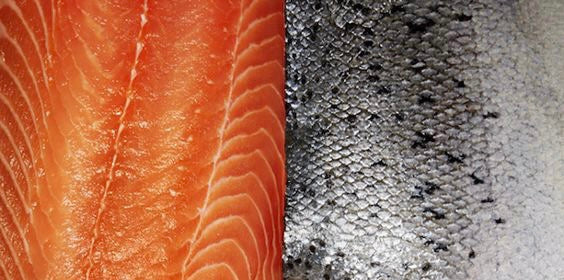The fish that tops our dietary blacklist: farm raised salmon

As the health benefits of consuming fish become more widely known, many people are leaning into the pescatarian lifestyle. We get it! Fish is rich in omega-3 fatty acids, essential vitamins, and beneficial minerals like magnesium, iron, and zinc, and research has shown that people who eat fish regularly have a lower rate of mental decline as they age, a lowered risk of autoimmune disease, and are less likely to experience depression.
Unfortunately, as the demand for fish has increased, so has the number of large-scale fish farms. Not only does raising fish in these farmed conditions typically reduce their nutritional benefits, many fish farms are causing overwhelming damage to the environment and threatening the health of wild fish. Because of this, it’s absolutely essential that we make informed decisions about which types of fish we consume.
3 Reasons to Switch to Wild Salmon
I won't lie. Farm raised salmon tastes better. It's rich and fatty, it almost has a buttery taste and I prefer it! But while most species of fish are affected by the negative impact of fish farming, salmon are one of the most notable. The benefits of eating salmon are well known, making it one of the most commonly consumed fish. However, it’s also one of the worst offenders.
In actuality, the nutritional benefits of salmon depend entirely on its source. Wild-caught salmon offers the many impressive health benefits commonly associated with a fish-rich diet, but the farmed variety is deprived of nutrients and full of contaminants.
- Farm raised salmon are lower in nutrients and higher in fat.
One of the most prominent differences between wild-caught and farm raised salmon is their diet. Salmon raised in their natural environment feed on zooplankton, algae, and smaller fish. Farmed salmon are fed a diet that is high in fat and protein to yield larger fish that mature more quickly. This dry pellet food contains genetically engineered soy products and pesticides—It’s also high in vegetable oils like grapeseed and canola. This unnatural diet dramatically depletes the fish’s nutritional value, and farm raised salmon are higher in calories, fat, and sodium, but lower in calcium, iron, potassium, magnesium, and zinc.
- Farm raised salmon are full of contaminants.
Polychlorinated biphenyls (PCBs) are industrial chemicals that were prominent throughout the 20th century until they were banned in 1979. These toxins have been shown to cause cancer and compromise the nervous, endocrine, and immune systems. Unfortunately, fish are one of the most prominent sources of PCBs, particularly those that are raised in contaminated waters.
While wild-caught salmon are exposed to contaminants—including PCBs—during their lifetime, a 2004 study determined that the PCB concentration in farm raised salmon was, on average, eight times higher than in wild-caught salmon.
- Salmon farms breed parasites that threaten the wild salmon population.
Lepeophtheirus salmonis, commonly known as sea lice, are a parasite that prey on fish to survive. Even though sea lice are present in the wild, finding a host in natural conditions is a significant challenge. But due to the density in fish farms, these parasites are able to thrive, and have been shown to infect wild fish swimming nearby.
Sea lice feed off salmon skin, leaving lesions that make them unsuitable for consumption. Major infestations in fish farms can cause mass mortality, which is a significant financial loss for farmers. As a result, harsh chemicals are often used to prevent the spread of sea lice, which adversely affects the health of the farm raised salmon.
3 Types of Fish to Avoid
- Farm raised tilapia
- Bluefin tuna, as they contain high levels of mercury and PCBs
- Chilean sea bass are overfished and contain high levels of mercury
3 Healthy Alternatives
- Albacore tuna, specifically troll- or pole-caught in the U.S. or British Columbia, are higher in omega-3s and lower in mercury and contaminants than other tuna.
- Pacific wild caught sardines reproduce quickly and are high in omega-3s and vitamin D.
- Farmed rainbow trout are raised in an ecologically responsible way, making them lower in contaminants than lake trout.
The health benefits of eating a diet rich in fish are enough to make even the most devoted meat-eaters consider a switch to pescatarianism—but it’s essential to understand which types of fish should be avoided and why. Once you know the detrimental impact salmon fish farms have on our health and the environment, it makes it easier to spend just a little more on a beautiful, wild-caught fillet instead of a pale pink, fatty farmed one.
We encourage you to research your favorite types of fish and to always ask the source of the fish on restaurant menus — You are your #1 health advocate and the changes you make in your own life have the power to inspire others and positively impact our world.
***THESE STATEMENTS HAVE NOT BEEN APPROVED OR REGULATED BY THE FDA. WE ARE NOT DOCTORS, THEREFORE ALWAYS CONSULT WITH YOUR DOCTOR FIRST.





